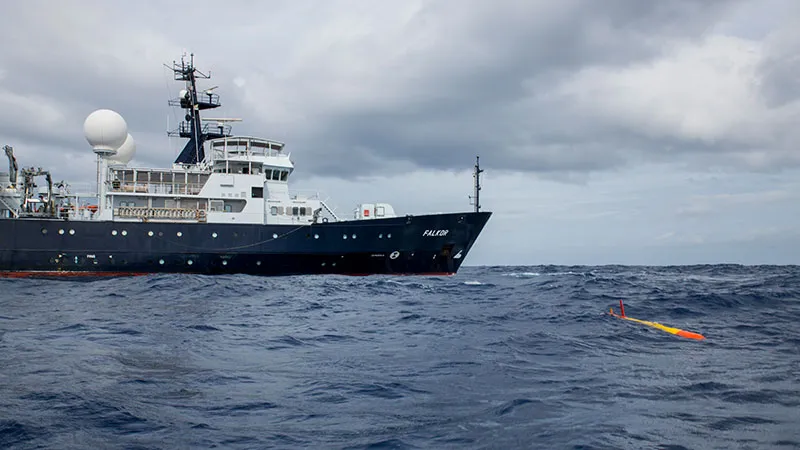These Underwater Robots Offer a New Way to Sample Microbes From the Ocean
The health of forests of underwater plankton have a big impact on the environment, and oceanographers are just starting to understand it
/https://tf-cmsv2-smithsonianmag-media.s3.amazonaws.com/filer/5b/65/5b6590c7-7e44-499e-a7e7-3c83f158e1ee/underwater-long-range-robot.jpg)
Off the north shore of Maui, a pair of torpedo-shaped submersibles are performing an intricate dance inside a spinning column of water. As the eddie rotates counterclockwise, pulling sediment and nutrients up from the deep, one of these long-range underwater autonomous vehicles floats patiently, gathering samples of the microbial life within the column, while the other propels itself in laps, testing the salinity and temperature of the water. Aboard a nearby ship, oceanographers from the University of Hawaii keep tabs and, when necessary, make adjustments to the vehicles’ trajectories.
The project is a collaboration between the University of Hawaii at Manoa, the Schmidt Ocean Institute, and the Monterey Bay Aquarium Research Institute (MBARI) to sample water, sequence the genomes of the microscopic life within it, and use that data to better understand the vertical layers of water within these eddies and how the life within them impacts the productivity of the ocean, including the food chain, and carbon production and storage. Microbes, including photosynthesizing phytoplankton, can absorb carbon dioxide and draw it deep into the ocean, but can also produce other greenhouse gases.
“These are not bit players. Microbes in the ocean control elemental cycles and form the basis for the food chain. Generally speaking, they’re really important in the ocean,” says Ed DeLong, a professor of oceanography at the University of Hawaii. “It’s this sort of physical-biological interaction, these eddies spinning, that can bring nutrients up and cause phytoplankton blooms, that we’re trying to understand. These eddies can probably have a large influence on how productive the ocean is, how much plant life is out there, how good are the forests growing. That’s really hard to study and not that well understood.”
DeLong, along with University of Hawaii professor Dave Karl, are the principal investigators on the first voyage of the long-range autonomous underwater vehicles. Though DeLong has long been studying the microbial communities in the ocean, the time and cost involved in sending out a ship to take samples has limited the amount of information he can gather. With funding from the Simons Foundation, he and Karl worked with MBARI to design the vehicles, which finished their first two-week mission on March 24, and have just left for another two weeks. They’ll remain near or in the eddie, which is currently spinning counterclockwise a hundred or so miles north of Maui. While using the trip as a practice run for the vehicles, the researchers are aiming to get a series of four-dimensional snapshots of the water and the microbes to show how their communities and actions change over time.

At up to 10 feet long and 12 inches in diameter, the robots look enough like torpedoes that they’re labeled “NOT A WEAPON.” (The team made three, but only two have been deployed.) A single prop, powered by lithium ion batteries, will drive them up to 600 miles on a charge. A satellite connection helps control the maneuvers, and larger packets of data are transmitted when the vehicles are within range of Wi-Fi or cellular data. Housed inside is a smaller version of a commercially available environmental sample processor (ESP) built by engineers at MBARI.
Jim Birch, who manages the ESP program at MBARI, also helped design and build the underwater vehicles. That involved minimizing drag and energy consumption, as well as implementing a sliding battery pack (to move mass forward/backward and tilt the nose down or up) and an external bladder, expandable with oil, to change the buoyancy. The devices can be deployed quickly, to scout out eddies seen from a satellite, and can travel serenely below a storm. The option for neutral buoyancy makes them well suited to floating in eddies, but that’s not the only situation they could be useful. They offer more active alternatives to less mobile devices, like the 4,000 buoy-shaped floating Argos operated by the University of California, San Diego, that sink and rise in the vertical plane. Wave gliders and sail drones cruise the surface, but can’t examine deeper ocean layers. The Woods Hole Oceanographic Institution operates a handful of autonomous vehicles, including some that dive very deep and some that move without propulsion, relying on current and an oil-filled bladder similar to the MBARI device, with the big difference being the combination of the Hawaii/MBARI vehicle’s long range and ESP sampler. There are so many unmanned underwater autonomous vehicles out there already that, in 2012, The Economist published a story called “20,000 Colleagues Under the Sea” about buoyancy-powered sea gliders like the one from Woods Hole.
“Studying the ocean is like studying Mars, or Jupiter,” says Birch. “We can go out into it a little bit more often, but it is a harsh, harsh environment, and sending robots out that can stay for a long period of time relative to what we do now, is a huge leap. This is going to transform oceanography.”

